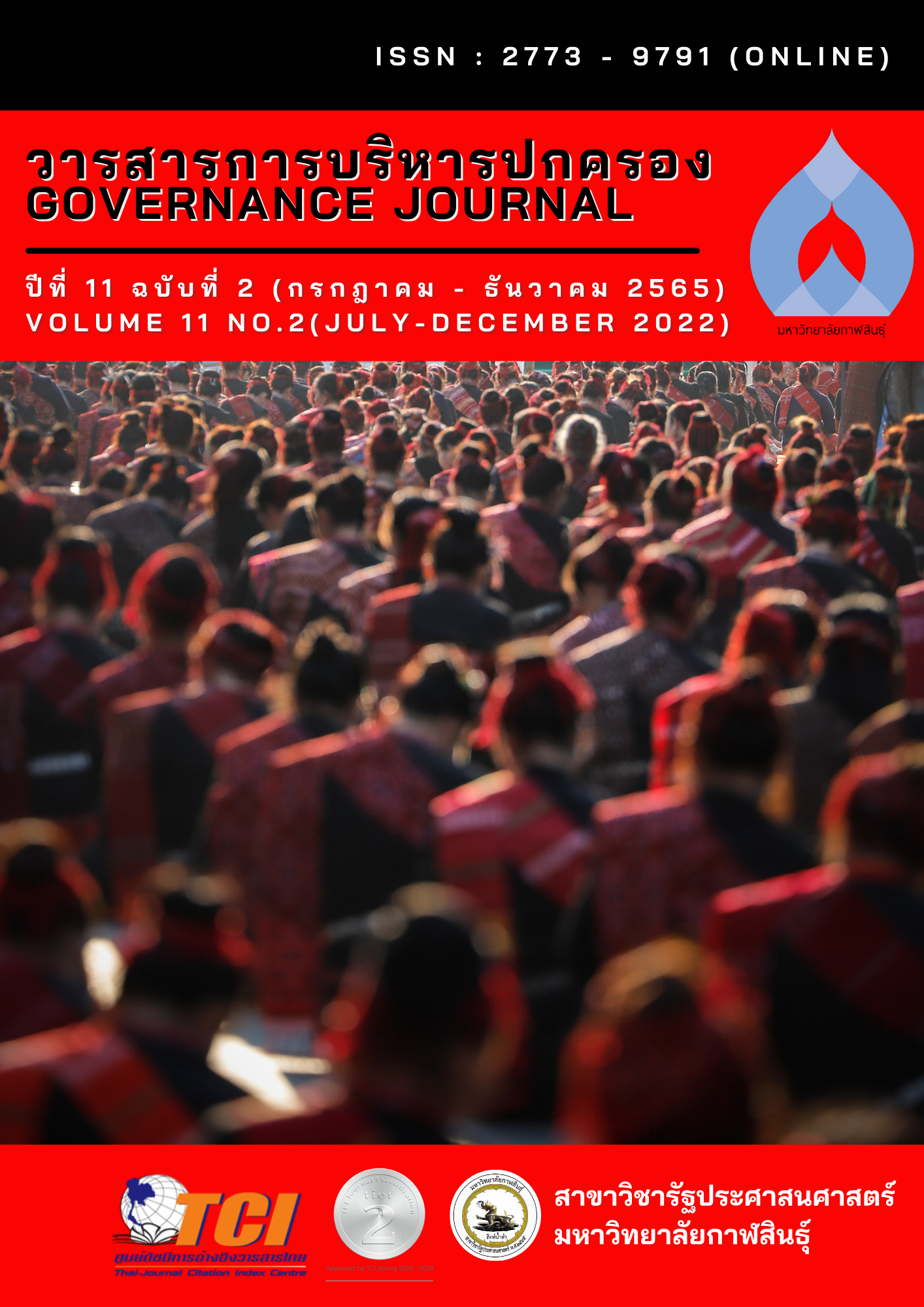พลวัตของเมืองกับยุทธศาสตร์การป้องกันภัยพิบัติทางธรรมชาติ
DOI:
https://doi.org/10.14456/gjl.2022.23คำสำคัญ:
ภัยพิบัติทางธรรมชาติ ; ปัญหาการจัดการภัยพิบัติ ; ยุทธศาสตร์การจัดการภัยพิบัติบทคัดย่อ
เหตุการณ์วิกฤตการณ์ต่าง ๆ ทางธรรมชาติที่เกิดขึ้นรอบโลกในปัจจุบันนี้ ได้ สะท้อนให้เราเห็นว่า วิกฤติไม่ใช่เป็นเรื่องที่ไกลตัวของมนุษย์ ประเทศต่าง ๆ ในโลกมีการเชื่อมโยงถึงกัน เหตุการณ์ทางธรรมชาติที่เกิดขึ้นในประเทศหนึ่งย่อมมีผลกระทบต่อประเทศอื่น ๆ ทั้งในอนุภูมิภาคเดียวกันและภูมิภาคใกล้เคียงกันได้ อีกทั้งทวีปอื่น ๆ ที่อยู่อีกซีกโลกหนึ่งก็ย่อมได้รับผลกระทบที่เกี่ยวข้องทั้งทางตรงและทางอ้อมอย่างหลีกเลี่ยงได้ยาก ภัยพิบัติทางธรรมชาติ เช่น พายุแผ่นดินไหว น้ำท่วม สึนามิ ภูเขาไฟระเบิด ไฟป่า เป็นต้น จวบจนภัยอื่น ๆ ที่อาจเข้ามาแทรกระหว่างกลางอย่าง COVID-19 ที่อาจโถมทวีความรุนแรงของภัยธรรมชาติมากขึ้นไปอีก บทความวิจัยฉบับนี้ช่วยสะท้อนให้เห็นถึงปัญหาการจัดการภัยพิบัติในประเทศไทยที่มักประสบในการนำนโยบายไปปฏิบัติ การขาดความพร้อมในการประสานงานของหน่วยงานต่าง ๆ เพื่อเตือนภัยแก่ผู้ที่อยู่ในเขตพื้นที่ประสบภัยให้อพยพหนีมาอยู่ในเขตที่ปลอดภัย ประชาชนทั่วไปขาดความรู้ความเข้าใจในการรับมือ รวมถึงปัญหาการจัดการวิกฤตการณ์ต่าง ๆ ในสถานการณ์ภัยพิบัติทางธรรมชาติดังกล่าว เมื่อเกิดเหตุการณ์ดังกล่าวประชาชนเกิดการแตกตื่นโกลาหล ขาดทิศทางที่ชัดเจนในการรับมือกับภัยพิบัติทางธรรมชาติดังกล่าว ผลที่ตามมาเกิดความเสียหายต่อชีวิตและทรัพย์สินจำนวนมาก จนบางสถานการณ์อาจกลายเป็นโศกนาฏกรรมครั้งสำคัญได้ ผู้เขียนนำเสนอยุทธศาสตร์พร้อมมาตรการที่เหมาะสมสำหรับการรับมือในกับภัยพิบัติทางธรรมชาติสำหรับหน่วยงานราชการ ภาคเอกชน ภาคประชาสังคม และภาคประชาชน รวม 4 ยุทธศาสตร์ ประกอบด้วย ยุทธศาสตร์การลดผลกระทบจากภัยพิบัติทางธรรมชาติ ยุทธศาสตร์การเตรียมความพร้อมรับมือภัยพิบัติทางธรรมชาติ ยุทธศาสตร์การรับมือภัยพิบัติทางธรรมชาติ และยุทธศาสตร์การฟื้นฟูจากภัยพิบัติทางธรรมชาติ
Downloads
เอกสารอ้างอิง
ภาษาไทย
กรมป้องกันและบรรเทาสาธารณภัย. (2560). มาตรฐานข้อมูลด้านสาธารณภัย. เรียกใช้เมื่อ 10 กรกฎาคม 2563 จาก http://portal.disaster.go.th/portal/public/client/ClientManual.pdf?ms=1558840708496
กรุงเทพธุรกิจ. (2563). ‘New Normal’ คืออะไร? เมื่อโควิด-19 ผลักเราสู่ชีวิต 'ปกติวิถีใหม่' ! เรียกใช้เมื่อ 12 กรกฎาคม 2563 จาก https://www.bangkokbiznews.com/news/detail/882508
กองเผยแพร่และประชาสัมพันธ์ กรมป้องกันและบรรเทาสาธารณภัย. (1 พฤษภาคม 2565). ปภ.เผยสรุปสถิติสาธารณภัยในรอบปี 64. เรียกใช้เมื่อ 11 ธันวาคม 2565 จาก http://relation.disaster.go.th: http://relation.disaster.go.th/cmsdetail.PRDPM
ชาตรี ปรีดาอนันทสุข. (2555). เปลี่ยนมุมมองของการจัดการวิกฤตด้วยแนวคิดการจัดการวิกฤตเชิงบูรณาการ. วารสารบริหารธุรกิจ เศรษฐศาสตร์และการสื่อสารมหาวิทยาลัยนเรศวร, 8(1), 27-38.
ทวิดา กมลเวชช. (2555). คู่มือการจัดการภัยพิบัติท้องถิ่น. พิมพ์ครั้งที่ 2. กรุงเทพฯ: บริษัท ธรรมดาเพลส จำกัด.
พัชราภา ตันตราจิน. (2563). การจัดการปกครองแบบร่วมคิดร่วมทำ (Collaborative Governance): ปัจจัยที่มีผลต่อการสร้างและนำไปปฏิบัติ. เศรษฐศาสตร์การเมืองบูรพา, 139-162.
พิชญ์ พงษ์สวัสดิ์. (28 มิถุนายน 2559). เมืองที่รับมือกับการเปลี่ยนแปลงได้. เรียกใช้เมื่อ 12 ธันวาคม 2565 จาก https://www.matichon.co.th/columnists/news_191562
ไมตรี จงไกรจักร. (29 กรกฎาคม 2564). เสวนาออนไลน์ภัยพิบัติซ้ำซ้อน (Compound Hazard) : ความเสี่ยงภัยใกล้ตัว. สสส. (สำนักงานกองทุนสนับสนุนการสร้างเสริมสุขภาพ) : ThaiHealth. จาก https://web.facebook.com/304196827037305/videos/533698064638243
รัชวิชญ์ วังศรี. (2564). ภัยพิบัติทางธรรมชาติกับความมั่นคงของชาติ: ปัญหาและผลกระทบจากการบังคับใช้กฎหมาย. นิติปริทัศน์, 1(2), 27-49.
วีรภาคย์ ซำศิริพงษ์ และจรูญศรี มาดิลกโกวิท. 2560. แนวทางการศึกษาชุมชนเพื่อการรับมือภัยพิบัติซ้ำซ้อนผ่านการมีส่วนร่วมของผู้มีส่วนได้เสีย. วารสารอิเล็กทรอนิกส์ทางการศึกษา,12(1),75-88.
ศิรศักย เทพจิต. (2563). COVID-19 Pandemic : การตอบสนองเชิงนโยบายสาธารณะในการรับมือกับปัญหาพยศ. เรียกใช้เมื่อ 13 กรกฎาคม 2563 จาก http://www.setthasarn.econ.tu.ac.th/blog/detail/59/
สมพร คุณวิชิต. (2561). ความรู้เบื้องต้นเกี่ยวกับการจัดการสาธารณภัยแบบเบ็ดเสร็จ. สงขลา: พี.ซี.พริ้นติ้ง.
เอกราช บุญเริง และอโณทัย หาระสาร. (2561). กลยุทธ์ในการจัดการภัยพิบัติทางธรรมชาติของประเทศไทย. วารสารการเมืองการปกครอง, 8(2), 100-115.
ภาษาอังกฤษ
Jon Coaffee. (2008). Risk, resilience, and environmentally sustainable cities. Energy Policy, 36(12), 4633-4638. doi:https://doi.org/10.1016/j.enpol.2008.09.048.
Lindell et al. (2007). Wiley Pathways Introduction to Emergengy Management. Hoboken, NJ: John Wiley & Sons.
OECD. (10 December 2018). Building Resilient Cities An Assessment of Disaster Risk Management Policies in Southeast Asia. เรียกใช้เมื่อ 12 December 2022 จาก https://www.oecd-ilibrary.org/sites/9789264305397en/1/1/5/index.html?itemId=/content/publication/9789264305397en&_csp_=952c06d7c05897debbb9feaa6463bbc3&itemIGO=oecd&itemContentType=book
Translated Thai References
Bangkokbiz (2020). What is the 'new normal'? Push us into life. 'New Normal' ! Retrieved 12 July 2020 from https://www.bangkokbiznews.com/news/detail/882508
Chatri PridaAnantasuk (2012). Changing the perspective of crisis management with the concept of integrative crisis management. Business Administration Journal Economics and Communication, Naresuan University, 8(1), 27-38.
Department of Disaster Prevention and Mitigation. Ministry of Interior. (2017). Disaster Information Standards. Retrieved on July 10, 2020 from http://portal.disaster.go.th/portal/public/client/ClientManual.pdf?ms=1558840708496
Division of Public Relations in Department of Disaster Prevention and Mitigation (2022). Retrieved 11 December 2022 from http://relation.disaster.go.th/cmsdetail.PRDPM
Ekkarad Boonreung and Anothai Harasarn. (2018). Strategies for Managing Natural Disasters in Thailand. Journal of Politics and Governance, 8(2), 100-115.
Eakarat Boonreang and Anothai Harasarn (2020). COVID-19 Pandemic : Public policy responses to dealing with the nod. Retrieved 13 July 2020 from http://www.setthasarn.econ.tu.ac.uk/blog/detail/59/
Mitree JongKrichak. (29 July 2021). Compound Hazard Online Conferment. Thai health. https://web.facebook.com/304196827037305/videos/533698064638243
Patcharapa Tantrajin (2020). Collaborative Governance: Factors Affecting Creation and Implementation. Burapha Journal of Political Economy,139-162.
Pitch pongsawat (2016). Cities that can cope with change. Retrieved 12 December 2022 from https://www.matichon.co.uk/columnists/news_191562
Rajwit Wang Si. (2021). Natural Disasters vs. National Security: Problems and Consequences of Law Enforcement.
Somporn Khunwichit. (2018). Introduction to comprehensive disaster management. Songkhla: T.C. Printing.
Tavida Kamolvej. (2012). Handbook for Local Disaster Management. 2nd edition. Bangkok: Normal Place Co., Ltd.
Weerapak Samsiripong and Charoonsri Madiloggovit. Community Education Guidelines for Recurrent Disaster Response Throughstakeholder Participation. An Online Journal of Education (OJED), 12(1), 75-88.
ดาวน์โหลด
เผยแพร่แล้ว
รูปแบบการอ้างอิง
ฉบับ
ประเภทบทความ
สัญญาอนุญาต

อนุญาตภายใต้เงื่อนไข Creative Commons Attribution-NonCommercial-NoDerivatives 4.0 International License.








